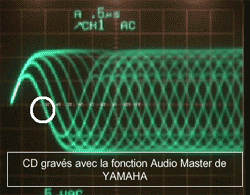Trailblazing with CRW-F1 and DiscT@2!
New Generation Audio Master Quality

The CRW-F1 uses Advanced Audio Master Quality Recording technology. As the name implies, this is a more advanced version of the Audio Master Quality Recording on the earlier CRW 3200s and CRW70. It differs from the previous version mainly in that it supports AMQ burning in 8X rather than 4X. This is a genuine improvement because it brings recording time down to about ten minutes.


To understand the way Audio Master Quality Recording works, we first need to talk about jitter. On a CD, the 0s and 1s of the digital sound are represented by what are known as pits and lands, pits being the zones burned by the laser. Next to these data is information for error correction. In theory, the data representing the 0s and 1s should not contain any errors. But every electronic appliance produces interference and random events, which sadly complicate matters. In a burning operation, errors called C1 and C2 occur, and this is what is known as jitter.

Yamaha claims that Audio Master Recording can reduce jitter by 30% compared to a standard recording, and can improve the quality of sound restitution. They have done this by modifying the laser speed in their new model, which burns a CD-R at 1.4 meters per second instead of 1.2 m/s, since the length of each pit depends largely on the speed at which it is burned. So if the speed is increased from 1.2 m/s to 1.4 m/s, the length of the pits increases by about 15%. This results in pits and lands which are slightly longer than usual, though still within the compatibility standards specified in the Red Book. A CD Audio, though burned at high speed, is more "legible" for audio drives and players. The downside is a substantial loss of space: 63 minutes for 650 MB (instead of 74); 68 for 700 MB (instead of 80); and 79 minutes for 790 MB (instead of 99).
Stay on the Cutting Edge
Join the experts who read Tom's Hardware for the inside track on enthusiast PC tech news — and have for over 25 years. We'll send breaking news and in-depth reviews of CPUs, GPUs, AI, maker hardware and more straight to your inbox.
Current page: New Generation Audio Master Quality
Prev Page Full CAV Mode Next Page Test Setup And MethodsMost Popular

